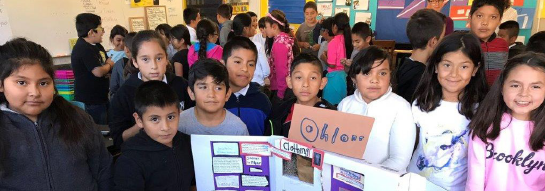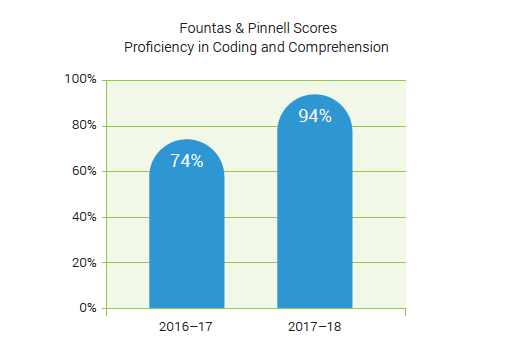Case Study
A Focus on Core Curriculum Implementation Facilitates MTSS and Accelerates Achievement

Dr. Michelle Rodriguez, Superintendent at Pajaro Valley Unified School District (PVUSD), is dedicated to raising student achievement among the vulnerable student populations served by the district. PVUSD, the largest district in Santa Cruz County, California, serves approximately 20,700 students. Of that student body:
- 15 percent are homeless, creating substantial amounts of mobility within schools
- 11 percent are migrant students who miss about 20 percent of the school year
- 14 percent participate in special education
Learn how PVUSD achieved impressive growth in literacy in 2017-18 among these student groups by strengthening Multi-Tiered Systems of Support (MTSS) through job-embedded professional development focused on curriculum implementation.
A Focus on Foundations
When Dr. Rodriguez became Superintendent at PVUSD during the 2016-17 school year, she was particularly unsettled by the 14 percent of students in special education.
“We often accelerated students directly to Tier 3, which contributed to our high number of special education students,” she explains. “But Tier 3 should be reserved for only a small number of students. When you have a system that isn’t functioning properly, Tier 3 expands and your Multi-Tiered Systems of Support (MTSS) looks like an inverted triangle.”
This was happening in PVUSD, despite implementing a standards-based curriculum and employing intervention teachers at every school site. When Tier 1 foundational instruction failed, students were sent directly to Tier 3. To flip the triangle, Dr. Rodriguez believed the district needed to fortify foundational instruction at Tier 1 and strengthen Tier 2. That meant training teachers to provide stronger support to all students in core curriculum subjects and teaching them to identify issues and intervene earlier.
An Opportunity for Improvement
One area the district concentrated on immediately was literacy. PVUSD had been using SIPPS (Systematic Instruction in Phonological Awareness, Phonics and Sight Words) as its core literacy program for five years, and they weren’t seeing progress. “We weren’t using SIPPS to fidelity,” Dr. Rodriguez says. “Specifically, teachers weren’t given the instruction or training to implement it well.” After partnering with CORE for six years in her previous position in Santa Ana Unified School District — and seeing 10 percent growth each year as a result — Dr. Rodriguez invited CORE to PVUSD to provide professional learning services and facilitate MTSS through more effective SIPPS implementation.
A New Approach
The district’s work with CORE started small with three pilot elementary schools in October 2017 and has now expanded to nine. Next year, all elementary schools will
participate. “We want to ensure everyone has the best job-embedded professional development possible,” Dr. Rodriguez explains.
CORE works hands-on with K-2 classroom teachers and instructional coaches, providing training within the context of the SIPPS curriculum and their own classrooms. “CORE is in the classroom with teachers observing lessons and providing feedback, assisting with lesson planning, and even modeling lessons to students,” Dr. Rodriguez says.
Special education teachers also are included in the general education SIPPS training. This is uncommon, but critical to the inclusive environment Dr. Rodriguez is striving to build. “If we’re really trying to establish an inclusive process, it’s then incumbent that special education teachers know what happens in foundational instruction,” explains Dr. Rodriguez. “We want our special education teachers to know the program and what students have been taught so they can provide stronger, more tailored supports.”
CORE also works with administration to ensure that the skills teachers have built are sustained over time. “I appreciate that after each visit, CORE debriefs all school sites,” Dr. Rodriguez says. These debriefings highlight positive growth the coaches have seen as well as issues that require follow-up. Dr. Rodriguez uses these summaries to extend additional support and resources to school sites as needed.
The focus of CORE professional learning differs from visit-to-visit — something Dr. Rodriguez appreciates most about CORE training. “CORE doesn’t make you fit into its mold” Dr. Rodriguez says. “They look at what our district needs and build an action plan around that while incorporating research and best practices. That’s rare and important.”
A Look at Results
CORE training is working in pilot schools, according to Dr. Rodriguez. “If you’re not a SIPPS pilot school, then chances are you’re not using the curriculum with fidelity, she says. “You’re going to have limited success even though it’s a great program,and you’re not going to see the growth other schools are seeing.”
Since working with CORE to implement SIPPS and build capacity for MTSS, PVUSD has experienced a 20 percent increase in achievement among first grade students in the SIPPS program. Fountas & Pinnell scores have moved from 74 percent proficiency in coding and comprehension to 94 percent proficiency today.

Over time, Dr. Rodriguez is confident that the gains made will expand beyond second grade students. “We know if we make kids readers by third grade, that will accelerate everyone’s scores as students move through the educational experience.”
Third Party Studies Find That CORE Professional Development Leads to Improved Reading Scores for PVUSD
Three studies conducted by SEG Measurement find that PVUSD students in classrooms where teachers received CORE professional development achieved greater growth in their reading skills.
In all three studies, conducted with first, second and third grade students, SEG Measurement found an effect size for the CORE professional development of .17, or about a fifth of a standard deviation. While many factors certainly contribute to student achievement (e.g. curriculum and instruction), these studies demonstrate that the professional development provided by CORE made a difference in student achievement. All three studies meet the ESSA evidence level 2.
The third-grade study was peer reviewed and presented at the November 2020 Innovate Learning Summit. Studies of the other two grades utilized the same methodology.
